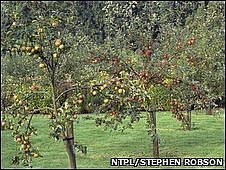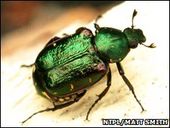
Use of few or no chemicals makes orchards good wildlife habitat
Traditional fruit orchards are vanishing from England's landscape - with serious consequences for wildlife, conservationists have warned.
The National Trust says 60% have disappeared since the 1950s, putting local varieties of apples, cherries, pears, plums and damsons under threat.
It is launching a £536,000 drive to reverse the decline of the orchards.
Their trees provide important habitats for species such as the noble chafer beetle and lesser spotted woodpecker.
The orchards - some with as few as five trees - also offer sources of pollen and nectar to bees, which are thought to be declining partly because of a lack of suitable food.
Pressure from commercial fruit growers has led many small-scale producers to develop their orchards or convert them to other uses.
The National Trust's head of nature conservation, Dr David Bullock, said traditional orchards had been "disappearing at an alarming rate over the last 60 years".
"We are in real danger of losing these unique habitats - and the wildlife, local fruit varieties and their rich heritage - and if we don't act in some cases we will not even know what local varieties of fruit have been lost," he said.
The trust has teamed up with government advisory body Natural England to launch the project to promote local fruit varieties.
It will undertake surveys to get a better understanding of the habitat, work to improve the condition of existing orchards and create new ones, and train people how to plant, prune and propagate trees.
Kate Merry has been appointed as orchard officer to champion the cause.
She said: "We now have a real opportunity to reverse the decline of traditional orchards and recognize the important role they play in our cultural and natural heritage; if we don't act there is a real danger they will not survive the 21st Century."
Hollowed and gnarledTrees in traditional orchards are widely spaced and the sites are often grazed by animals such as sheep, or cut for hay.
They provide a good habitat for wildlife because they are subject to low intensity management, with few or no chemicals used, and the trees are allowed to reach a stage where they are hollowed and gnarled.

The noble chafer beetle is among the rare species under threat
The noble chafer beetle makes its home in the dead wood of older fruit trees, while the lesser spotted woodpecker can also find nesting and feeding areas in the trees.
A survey by the National Trust last year of more than 100 traditional orchards in its care turned up a number of other species in the habitat, many of them rare.
At the Killerton estate in Devon, where the new program has been launched, surveys found insects including the orchard park beetle and the apple tree lace bag. It also proved a feeding ground for long-eared bats.
Apples - including two varieties unique to the estate - are used to make cider and chutney, with the profits used to maintain the orchards.
Poul Christensen, acting chairman of Natural England, said: "Successful orchards are worth their weight in gold, not just for the valuable contribution they make to the economy but to the subsequent enhancement of these precious wildlife habitats."
In 2007, the government prioritized orchards as habitat to protect in recognition of their importance to wildlife.


Reader Comments
to our Newsletter